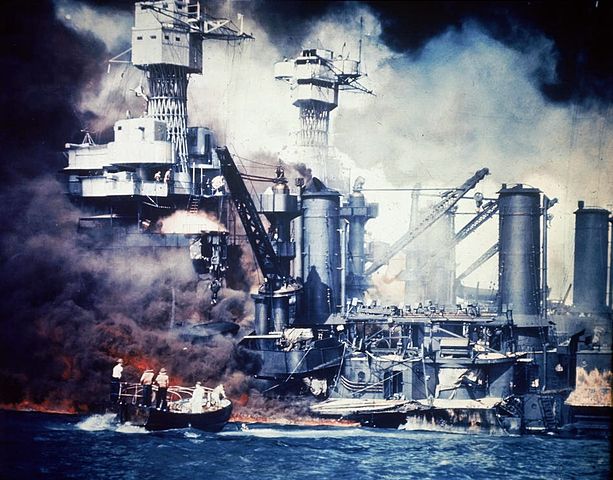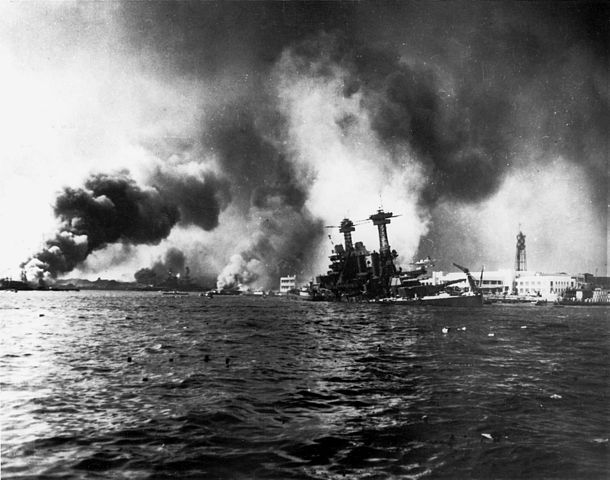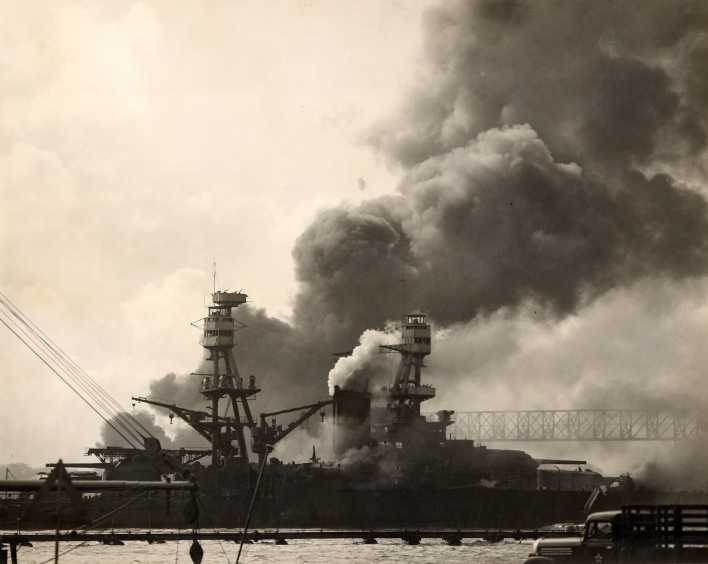Remembering Maritime History: A Date Which Will Live In Infamy

Aftermath: USS West Virginia (severely damaged), USS Tennessee (damaged), and the USS Arizona (sunk).
At 7:55 a.m. on December 7, 1941 in Hawaii, a Japanese dive bomber displaying the Rising Sun of Japan appeared above the island of Oahu. 360 Japanese warplanes followed, descending on the U.S. naval base at Pearl Harbor in a brutal assault. The surprise attack served as a critical setback against the U.S. Pacific fleet and drew the United States into the Second World War.
President Franklin D. Roosevelt and his advisers assumed a looming Japanese attack was probable, but nothing had been done to secure the vital naval base at Pearl Harbor.
Much of the Pacific fleet was rendered useless: Five of eight battleships, three destroyers, and seven other ships were sunk or severely damaged, and more than 200 aircraft were destroyed. A total of 2,400 Americans were killed and 1,200 were wounded, many while heroically attempting to ward off the attack.
Battleship USS West Virginia took two aerial bombs, both duds, and seven torpedo hits, one of which may have come from a midget submarine.

Fortunately for the United States, all three Pacific fleet carriers were out at sea on training maneuvers. These giant aircraft carriers would have their revenge against Japan six months later at the Battle of Midway, defeating the previously invincible Japanese navy in a spectacular victory.
The day after Pearl Harbor was bombed, President Roosevelt appeared before a joint session of Congress and declared, "Yesterday, December 7, 1941 - a date which will live in infamy - the United States of America was suddenly and deliberately attacked by naval and air forces of the Empire of Japan."
This week, President Obama proclaimed National Pearl Harbor Remembrance Day, 2013. He stated: “More than seven decades ago, on a calm Sunday morning, our Nation was attacked without warning or provocation. The bombs that fell on the island of Oahu took almost 2,400 American lives, damaged our Pacific Fleet, challenged our resilience, and tested our resolve. On National Pearl Harbor Remembrance Day, we honor the men and women who selflessly sacrificed for our country, and we show our enduring gratitude to all who fought to defend freedom against the forces of tyranny and oppression in the Second World War.”
Today, the USS Arizona Memorial on the island of Oahu honors the lives lost on the day of the attack. Visitors to the memorial reach it via vessels from the naval base at Pearl Harbor. It commemorates "initial defeat and ultimate victory" of all lives lost on December 7, 1941.
Battleship USS California sinking

Ships lost or damaged
Battleships
Arizona: hit by an armor-piercing bomb, exploded; total loss. 1,177 dead.
Oklahoma: hit by five torpedoes, capsized; total loss. 429 dead. Refloated November 1943; capsized and lost while under tow to the mainland May 1947.
West Virginia: hit by two bombs, seven torpedoes, sunk; returned to service July 1944. 106 dead.
California: hit by two bombs, two torpedoes, sunk; returned to service January 1944. 100 dead.
Nevada: hit by six bombs, one torpedo, beached; returned to service October 1942. 60 dead.
Tennessee: hit by two bombs; returned to service February 1942. 5 dead.
Maryland: hit by two bombs; returned to service February 1942. 4 dead (including floatplane pilot shot down).
Pennsylvania (Kimmel's flagship): in drydock with Cassin and Downes, hit by one bomb, debris from USS Cassin; remained in service. 9 dead.

Battleship USS Nevada attempting to escape from the harbor.
Ex-battleship (target/AA training ship)
Utah: hit by two torpedoes, capsized; total loss. 64 dead.
Cruisers
Helena: hit by one torpedo; returned to service January 1942. 20 dead.
Raleigh: hit by one torpedo; returned to service February 1942.
Honolulu: Near miss, light damage; remained in service.
Destroyers
Cassin: in drydock with Downes and Pennsylvania, hit by one bomb, burned; returned to service February 1944.
Downes: in drydock with Cassin and Pennsylvania, caught fire from Cassin, burned; returned to service November 1943.
Shaw: hit by three bombs; returned to service June 1942.
.jpg)
Destroyer USS Shaw exploding after her forward magazine was detonated
Auxiliaries
Oglala (minelayer): Damaged by torpedo hit on Helena, capsized; returned to service (as engine-repair ship) February 1944.
Vestal (repair ship): hit by two bombs, blast and fire from Arizona, beached; returned to service by August 1942.
Curtiss (seaplane tender): hit by one bomb, one crashed Japanese aircraft; returned to service January 1942. 19 dead.
After a systematic search for survivors, formal salvage operations began. Around Pearl Harbor, divers from the Navy (shore and tenders), the Naval Shipyard, and civilian contractors (Pacific Bridge and others) began work on the ships that could be refloated. They patched holes, cleared debris, and pumped water out of ships. Navy divers worked inside the damaged ships. Within six months, five battleships and two cruisers were patched or refloated so they could be sent to shipyards in Pearl Harbor and on the mainland for extensive repair. Intensive salvage operations continued for another year, a total of some 20,000 man-hours under water.
